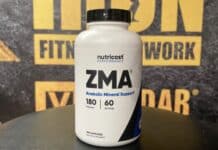
Adding a deficit to push ups increases the range of motion for more chest muscle contraction.
Push ups, often overlooked, are a potent exercise for strengthening the upper body. They mirror the muscle engagement in bench presses to build your chest (1). They’re ideal for warming up before bench pressing and are an excellent alternative on days away from the gym.
The deficit push up, a more challenging variant of the classic push up. By positioning your hands on an elevated platform, you effectively deepen the stretch and enhance the engagement of the targeted muscles.
This article delves into the deficit push up and showcases its significant benefits. Moreover, it provides an in-depth, step-by-step tutorial on executing this bodyweight exercise precisely. To further aid in amplifying your results, the guide offers several alternatives aimed at working the same upper body muscle groups.
Techniques & Muscles Worked
The deficit push up is a compound movement that targets the pecs, delts, and triceps. It also recruits other muscles, like the abs and obliques, which are used for stabilization. Additionally, performing push ups can increase cardiovascular fitness and improve overall health by reducing the risk of cardiovascular disease (2).
You can do this push up variation anywhere, making it the perfect bodyweight exercise for fitness gurus on the go. All you need is an elevated and stationary surface to place your hands. They could be blocks or kettlebells, as long as your hands don’t slip during the exercise. Below is a detailed step-by-step guide on how to do the deficit push up using blocks.
- Place two blocks on the floor and set them at shoulder-width length.
- Get into a push up position and place your hands on the blocks.
- Keep your back straight and arms fully extended from the blocks. Your knees should never touch the floor, and your feet should be shoulder-width apart. This is your starting position.
- Next, brace your core and slowly lower yourself below the blocks. The deeper you go, the more your chest will stretch. When you stop, you should be about one inch off the floor.
- Pause for about one to two seconds and push up explosively, reversing the movement back to the starting position to complete the rep.
- Repeat for as many reps as you desire.
Benefits
The deficit push up is a strength training and upper-body building exercise that mainly targets your chest. It targets multiple muscle groups and improves total-body coordination. Here are some key benefits of incorporating this workout into your training routines.
Effectively Builds the Upper Body
Performing a deficit push up strengthens and builds the upper body muscles. You can use it to sculpt your chest, shoulders and triceps. With consistency, you can get a good-looking and aesthetically pleasing upper body simply working with your bodyweight.
Increased Range of Motion
A deficit push up differs from the standard push ups because of the elevated platform. This elevation increases your range of motion. Performing deficit push ups gets you a deeper chest stretch and arm contraction, which can increase muscle hypertrophy.
Activates Core Muscles
The core muscles are essential when performing this exercise. Activating and keeping them under constant tension during this exercise improves balance and stability and reduces your chance of injuries.
Carryover to Other Exercises
Deficit push ups are an effective way to build upper body muscles and translate to better form in routines like the bench press and shoulder press, which also greatly activate the pecs, delts, and triceps to perform.
Deficit Push Up Alternatives
The deficit push up is an effective exercise for building, developing, and strengthening upper body muscles, primarily hitting your pecs. However, experts have advised mixing up other exercises that build similar muscles to avoid a training plateau. Below are a few excellent alternatives that allow you to add weights to engage your pecs.
Incline Bench Press
Incline bench presses are a compound movement that targets muscles similar to deficit push ups. These muscles include the chest, shoulders, and triceps. This exercise is done with a barbell, but you can also use other free weights like kettlebells and dumbbells. A Smith machine effectively provides extra stability and core concentration on target muscles.
High Cable Fly
The high cable fly is an isolation movement that primarily targets the pecs. It recruits and works other muscles, such as the shoulders and triceps. The cables provide constant tension on the target muscles, which is good for muscle growth.
Dip
Dips are a strength training exercise that also targets the chest, shoulders, and triceps. They allow you to sculpt your upper body by eliminating using your lower body. During this routine, you could use a weighted vest and/or resistance bands for more resistance and gains.
FAQs
How do you do a deficit push up?
Before you start this exercise, you need an elevated surface, preferably blocks set at shoulder width. Next, get into position, place your hands on the blocks, lower yourself by flexing your triceps, and then extend your arms to “push up.” Check out the exercise guide above for a more detailed step-by-step guide.
What is the difference between deficit push ups and normal push ups?
Deficit and normal push ups build your upper body muscles, specifically your chest, with the right form. The difference is that you can achieve a greater range of motion when performing deficit push ups. As a result, you also hit your target muscles better.
Are deficit push ups easier?
No, deficit push ups are difficult compared to regular push ups. The deficit push up is an advanced variation of the regular push up. However, with the right form, this extra difficulty can translate to more muscle gains.
Follow us on Instagram, Facebook, and Twitter for more exercise guides!
References
- Tillaar R. V. D. (2019). Comparison of Kinematics and Muscle Activation between Push-up and Bench Press. Sports medicine international open, 3(3), E74–E81. https://doi.org/10.1055/a-1001-2526
- Yang, J., Christophi, C. A., Farioli, A., Baur, D. M., Moffatt, S., Zollinger, T. W., & Kales, S. N. (2019). Association Between Push-up Exercise Capacity and Future Cardiovascular Events Among Active Adult Men. JAMA network open, 2(2), e188341. https://doi.org/10.1001/jamanetworkopen.2018.8341















